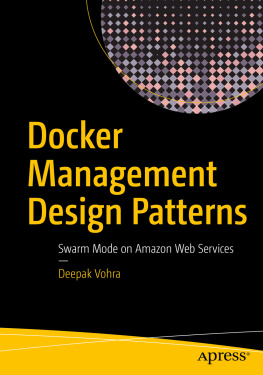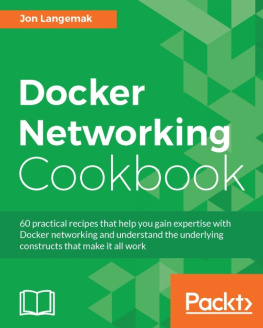Rajdeep Dua - Learning Docker Networking
Here you can read online Rajdeep Dua - Learning Docker Networking full text of the book (entire story) in english for free. Download pdf and epub, get meaning, cover and reviews about this ebook. year: 2016, publisher: Packt Publishing, genre: Computer. Description of the work, (preface) as well as reviews are available. Best literature library LitArk.com created for fans of good reading and offers a wide selection of genres:
Romance novel
Science fiction
Adventure
Detective
Science
History
Home and family
Prose
Art
Politics
Computer
Non-fiction
Religion
Business
Children
Humor
Choose a favorite category and find really read worthwhile books. Enjoy immersion in the world of imagination, feel the emotions of the characters or learn something new for yourself, make an fascinating discovery.

- Book:Learning Docker Networking
- Author:
- Publisher:Packt Publishing
- Genre:
- Year:2016
- Rating:4 / 5
- Favourites:Add to favourites
- Your mark:
- 80
- 1
- 2
- 3
- 4
- 5
Learning Docker Networking: summary, description and annotation
We offer to read an annotation, description, summary or preface (depends on what the author of the book "Learning Docker Networking" wrote himself). If you haven't found the necessary information about the book — write in the comments, we will try to find it.
Rajdeep Dua: author's other books
Who wrote Learning Docker Networking? Find out the surname, the name of the author of the book and a list of all author's works by series.
Learning Docker Networking — read online for free the complete book (whole text) full work
Below is the text of the book, divided by pages. System saving the place of the last page read, allows you to conveniently read the book "Learning Docker Networking" online for free, without having to search again every time where you left off. Put a bookmark, and you can go to the page where you finished reading at any time.
Font size:
Interval:
Bookmark:
Copyright 2016 Packt Publishing
All rights reserved. No part of this book may be reproduced, stored in a retrieval system, or transmitted in any form or by any means, without the prior written permission of the publisher, except in the case of brief quotations embedded in critical articles or reviews.
Every effort has been made in the preparation of this book to ensure the accuracy of the information presented. However, the information contained in this book is sold without warranty, either express or implied. Neither the author(s), nor Packt Publishing, and its dealers and distributors will be held liable for any damages caused or alleged to be caused directly or indirectly by this book.
Packt Publishing has endeavored to provide trademark information about all of the companies and products mentioned in this book by the appropriate use of capitals. However, Packt Publishing cannot guarantee the accuracy of this information.
First published: February 2016
Production reference: 1190216
Published by Packt Publishing Ltd.
Livery Place
35 Livery Street
Birmingham B3 2PB, UK.
ISBN 978-1-78528-095-5
www.packtpub.com
Authors
Rajdeep Dua
Vaibhav Kohli
Santosh Kumar Konduri
Reviewer
Jon Langemak
Commissioning Editor
Kunal Parikh
Acquisition Editor
Tushar Gupta
Content Development Editor
Mayur Pawanikar
Technical Editor
Dhiraj Chandanshive
Copy Editors
Joanna McMahon
Madhusudan Uchil
Project Coordinator
Nidhi Joshi
Proofreader
Safis Editing
Indexer
Rekha Nair
Graphics
Jason Monteiro
Production Coordinator
Aparna Bhagat
Cover Work
Aparna Bhagat
Rajdeep Dua has over 16 years of experience in distributed systems. He has worked in R&D and Developer Relation roles at Microsoft, Google, VMware, and Salesforce.com. He has exposure to multiple cloud platforms like Google App Engine, Heroku, Force.com, vSphere, and Google Compute Engine.
Rajdeep has been working on Docker and related container technologies for more than two years now. He did his MBA in IT from IIM Lucknow in the year 2000.
Vaibhav Kohli has around 3 years of working experience in the research and development department of VMware, and he has been teaching computer engineering for a year at the esteemed Mumbai University. He has published many research papers and filed three patents from VMware in the container domain. He has also conducted workshops in various companies and meetups on container technology (Docker) and Kubernetes.
Santosh Kumar Konduri has around 5 years of IT experience. He is an expert OpenStack administrator with 3 years of experience.
Jon Langemak has over 10 years of experience in designing, building, and maintaining high-performance networks. He's currently employed as a network architect at a Minnesota-based company, where he focuses on disruptive technologies and the impact they have on network operations. Outside of work, Jon blogs at www.dasblinkenlichten.com and enjoys collaborating with others in the networking community on new ideas and concepts.
Did you know that Packt offers eBook versions of every book published, with PDF and ePub files available? You can upgrade to the eBook version at > for more details.
At www.PacktPub.com, you can also read a collection of free technical articles, sign up for a range of free newsletters and receive exclusive discounts and offers on Packt books and eBooks.

https://www2.packtpub.com/books/subscription/packtlib
Do you need instant solutions to your IT questions? PacktLib is Packt's online digital book library. Here, you can search, access, and read Packt's entire library of books.
- Fully searchable across every book published by Packt
- Copy and paste, print, and bookmark content
- On demand and accessible via a web browser
This book helps the reader to learn, create, deploy, and provide administration steps for Docker networking. Docker is a Linux container implementation that enables the creation of light-weight portable development and production-quality environments. These environments can be updated incrementally. Docker achieves this by leveraging containment principles, such as cgroups and Linux namespaces, along with overlay filesystem-based portable images.
Docker provides the networking primitives that allow administrators to specify how different containers network with each application, connect to each of their components, then distribute them across a large number of servers, and ensure coordination between them irrespective of the host or the VM that they are running on. This book aggregates all the latest Docker networking technology and provides great in depth explanation with setup details.
, Docker Networking Primer , explains the essential components of Docker networking, which have evolved from coupling simple Docker abstractions and powerful network components, such as Linux bridges, Open vSwitch, and so on. This chapter also explains how Docker containers can be created with various modes. In the default mode, port mapping helps us through the use of iptables NAT rules, allowing traffic arriving at the host to reach containers. Later in this chapter, basic linking of the container is covered and the next generation of Docker networking, which is libnetwork, is also discussed.
, Docker Networking Internals , discusses Docker's internal networking architecture. We will learn about IPv4, IPv6, and DNS configurations in Docker. Later in this chapter, Docker bridge and communication between containers in single host and multihost is covered. This chapter also explains overlay tunneling and different methods that are implemented on Docker networking, such as OVS, Flannel, and Weave.
, Building Your First Docker Network , shows how Docker containers communicate from multiple hosts using different networking options, such as Weave, OVS, and Flannel. Pipework uses legacy Linux bridge, Weave creates a virtual network, OVS uses GRE tunneling technology, and Flannel provides a separate subnet to each host to connect containers on multiple hosts. Some of the implementations, such as Pipework, are legacy and will become obsolete over a period of time, while others are designed to be used in the context of specific OSes, such as Flannel with CoreOS. Basic comparisons of Docker networking options are also covered in this chapter.
, Networking in a Docker Cluster , explains Docker networking in depth using various frameworks, such as native Docker Swarm, where using the libnetwork or the out-of the-box overlay network, Swarm, provides the multihost networking features. Kubernetes, on the other hand, has a different perspective from Docker, where each pod will get a unique IP address and communication between pods can occur with the help of services. Using Open vSwitch or IP-forwarding advanced routing rules, the Kubernetes networking can be enhanced to provide connectivity between pods on different subnets across hosts and expose the pods to the external world. In the case of Mesosphere, we can see that Marathon is used as a backend for the networking of the deployed containers. In the case of DCOS of the Mesosphere, the entire deployed stack of machines is treated as one machine to provide a rich-networking experience between deployed container services.
Font size:
Interval:
Bookmark:
Similar books «Learning Docker Networking»
Look at similar books to Learning Docker Networking. We have selected literature similar in name and meaning in the hope of providing readers with more options to find new, interesting, not yet read works.
Discussion, reviews of the book Learning Docker Networking and just readers' own opinions. Leave your comments, write what you think about the work, its meaning or the main characters. Specify what exactly you liked and what you didn't like, and why you think so.









